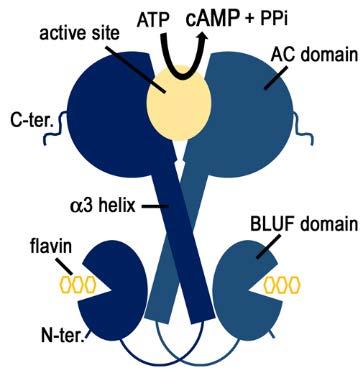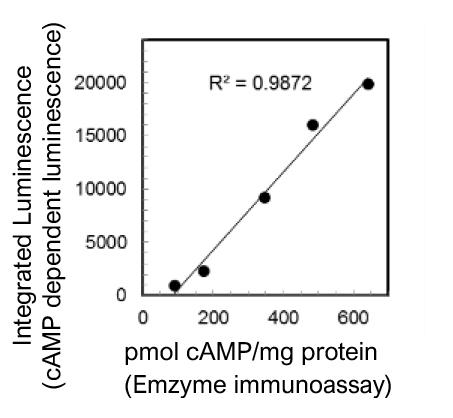Tools for Non-Neurological Optogenetics
AAV and plasmid Expression Vectors for C-terminal region-modified OaPAC (photoactivated adenylyl cyclase from Oscillatoria acuminata (OaPAC).
pmOaPAC348 | maximum luminescence at blue light stimulation intensity of 4.5 10^2 um/m^2/sec
rAAV2_mOaPAC348 | maximum luminescence at blue light stimulation of intensity at 4.5 10^2 um/m^2/sec
pmOaPAC360 | maximum luminescence at blue light stimulation intensity of 1.5 10^3 um/m^2/sec
rAAV2_mOaPAC360 | maximum luminescence at blue light stimulation intensity of 1.5 10^3 um/m^2/sec
Required Materials Transfer Agreement (MTA) for OaPAC vectors
Expression vectors for modified photoactivated adenylate cyclases (OaPAC) derived from the orchid algae (Oscillatoria acuminata).
In the field of life science, as a means of reproducing cell responses involving cyclic AMP (cAMP), which acts as a second messenger of signal transduction, and creating pathological models, it has excellent temporal and spatial flexibility and reproducibility, and precision that is difficult with drug administration. Expectations are rising for optical operations (Optogenetics) that can realize various controls. Photoactivated adenylyl cyclase (PAC), which produces cAMP by photostimulation, is directly activated by light without the intervention of G proteins, so the functions of various bioactive factors can be replaced by light. A promising tool. This product can also be applied to non-excitable cells, which is difficult with optogenetics using photosensitive ion channels . Please use it to induce various biological phenomena that occur on a cell- by- cell basis by the optical manipulation of cAMP signal transduction .
| Hamamatsu modified OaPAC vector ordering information | Cat. No. | qty |
| pmOaPAC348 for academic user | HPK-BD1177A | 10 UG |
| pmOaPAC348 for commercial user | HPK-BD1177 | 10 UG |
| rAAV2_mOaPAC348 for academic user | HPK-BD1179A | 20 UL |
| rAAV2_mOaPAC348 for commercial user | HPK-BD1179 | 20 UL |
| pmOaPAC360 for academic user | HPK-BD1178A | 10 UG |
| pmOaPAC360 for commercial user | HPK-BD1178 | 10 UG |
| rAAV2_mOaPAC360 for academic user | HPK-BD1180A | 20 UL |
| rAAV2_mOaPAC360 for commercial user | HPK-BD1180 | 20 UL |
Background

Figure 1. Schematic of the OaPAC homodimer
OaPAC subjunits contain both a BLUF domain (sensor of blue-light using FAD) and an AC (adenylyl cyclase) domain such that intracellular second messenger cAMP production can be induced with blue light in a light intensity-dependent manner.
Modified OaPACs OaPAC348 and OaPAC360 have different photoactivity depending on the length of their C-terminal.
Neither OaPAC348 nor OaPAC360 is active in the dark, eliminating the need for light manipulation in a completely dark room, which is required when using bPAC derived from the sulfur bacterium Beggiatoa. In addition, they have 15x to 50x higher photosensitivity than wild-type OaPAC. The plasmid vectors contain an ampicillin resistance gene for selection in E. coli, while the AAV vectors are the highly versatile serotype 2 and have contain an RFP (red fluorescent protein, (Ex555nm/Em584nm) gene as an expression marker for PAC gene.
Figure 2
C-terminal amino acid sequences of modified OaPACs. Vector sequences are codon-optimized for mammalian expression.

Figure 3
Comparison of cAMP-dependent luminescence to stimulated blue light intensity of bPAC ( Beggiatoa PAC), OaPAC WT and C-terminal deletion mutants

Fig. 4
Correlation between cAMP-dependent integrated luminescence and absolute concentration by EIA (intra-HEK293 cells)

Figure 5.
Left Panel: Suppression of expression of cAMP signal mediator Epac and photostimulation of PAC induce axon branching.
Right Panel: Suppression of expression of cAMP signal mediator PKA and photostimulation of PAC induce axon elongation.
Attribution: Scientific Reports 5, Article number 19679.

References
Hirano et al. (2019), “The C-terminal region affects the activity of photoactivated adenylyl cyclase from Oscillatoria acuminata.” Scientific Reports 9, Article number: 20262.
Ohki et al. (2016), “Structural insight into photoactivation of an adenylate cyclase from a photosynthetic cyanobacterium.” PNAS 113 (24) 6659-6664.
Zhou, Z. et al. (2016), “Photoactivated adenylyl cyclase (PAC) reveals novel mechanisms underlying cAMP-dependent axonal morphogenesis. ” Scientific Reports 5, Article number 19679.
